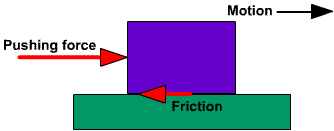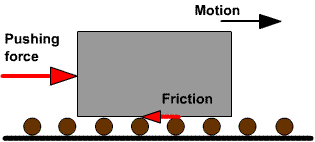|
Friction is a force that resists the
motion caused by another force on an object. The
requirement for friction is that the object must be in
contact with another object or material and an external
force must be applied on the object in an attempt to
move it. The type of motion determines the different
types of friction, which are sliding, rolling and fluid
friction. If the object does not move, the friction is
considered static. If the force is sufficient to move
the object, the friction is called kinetic. The cause of
friction is a combination of surface roughness,
molecular adhesion and deformation effects.
Questions you may have about friction
include:
-
What are static and kinetic friction
in sliding friction?
-
What are the factors in rolling
friction?
-
What are the causes of fluid
friction?
Sliding friction
When two solid objects are in contact
and a force is applied to slide one object against the
other, sliding friction force resists the motion. If F
is the force pushing on an object and Fr is the force of
friction, the relationship between F and Fr will
determine whether the object will slide or not move at
all.
If force F is greater than friction Fr
(written as F > Fr), then the object will slide or move.
The friction is considered kinetic friction, which means
moving friction.

Pushing force greater than friction
force
If F is less than Fr (written as F <
Fr), there is no motion and the objects remain static
with respect to each other. In this case, the friction
is considered static friction, which means it is not
moving.
What is interesting is that the static
friction that holds an object in place is greater than
the kinetic friction that slows down a moving object. In
other words, once you start an object moving, the
friction decreases from the static friction holding the
object in place.
You have seen this in trying to slide a
heavy box across the floor. It may be very difficult to
move, but once it starts sliding, it is easier to push.
The causes of sliding friction are
surface roughness of the materials, molecular attraction
or adhesion between the materials, and deformation
resistance in the case of soft materials.
Rolling friction
When a ball or wheel is in contact with
a solid object and a force is applied to the wheel, it
will start to roll due to the friction at the point of
contact with the other surface. This is the starting
friction for a wheel.
Once the wheel starts rolling, there is
a resistive force that slows the wheel's motion on the
other surface. This is called rolling friction.
When a force is applied to a wheel is
not enough to overcome the static force of friction, the
wheel will start to roll. If the force is greater than
the static resistance, the wheel will slide or spin. It
will also roll, but not at the same rate as with static
friction.
A good example of this is accelerating
an automobile on wet pavement. Pushing on the
accelerator peddle too hard will cause the wheels to
spin, and the car will not move forward as fast as when
you push on the gas peddle less.
Once the wheel is rolling, friction at
the point of contact with the other surface slows down
the motion of the wheel. Typically, rolling friction is
much less than sliding friction. A wheel can roll for
some distance before slowing down and stopping.
But there are situations where rolling
friction can be large. Trying to ride a bicycle in loose
dirt is an example of friction greatly slowing down the
rolling motion.
An advantage of rolling friction is that
it is much less than sliding friction.
When the Great Pyramids were being build
in ancient Egypt, they used logs as rollers under the
giant blocks of granite instead of trying to slide the
rocks along the ground.

Rollers reduced friction when moving
granite block
The causes of rolling friction are
similar to that of sliding friction. They are surface
roughness of the materials, molecular attraction or
adhesion between the materials, and deformation
resistance in the case of soft materials. Included in
surface roughness is the existence of treads on the
wheel or tire.
Fluid friction
When a solid object is in contact with a
fluid, such as a liquid or gas, and a force is applied
to either the object or the fluid, there is a friction
force that resists the motion. Examples where fluid
friction occurs are water flowing through a hose, an
airplane flying through the atmosphere, and oil
lubricating moving parts.
If the viscosity or thickness of the
fluid is great, there may be no movement due to static
friction. One example is trying to move heavy grease
through a hose. You need to apply a great pressure to
finally break the static friction and start the grease
moving.
Once a fluid moves through a hose or an
object is moving along a fluid, the resistance is
considered kinetic friction. The grease will still move
much slower than a fluid with low viscosity, like water.
Causes of fluid friction are turbulence
effects from surface roughness and deformities,
molecular attraction or adhesion between the materials,
and deformation resistance of the fluid.
In conclusion
Friction is a force that resist the
motion of the object that is in contact with another
object or material. The forms of motion determine the
types of friction, which are sliding, rolling and fluid
friction. Friction be static when the objects don't move
or kinetic when they are moving. The cause of friction
is a combination of surface roughness, molecular
adhesion and deformation effects. |